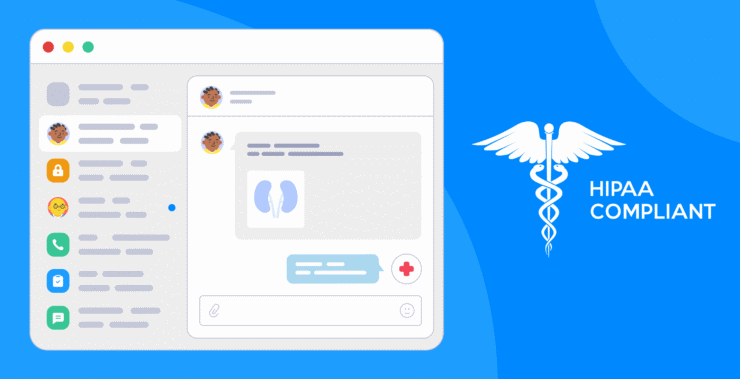Let’s be honest – sometimes one single message is the fastest way to show up for someone. Whether it’s about checking in on a patient’s progress, coordinating with a colleague, or responding to a sudden mental health concern, a simple text can make all the difference. Texting has naturally become a go-to communication channel, especially in today’s therapy, where speed and accessibility matter more than ever.
For many therapists, the complete shift to online messaging therapy didn’t start as a trend. It starts from the necessity.
Its roots go back to the pandemic, when in-person visits dropped overnight, and texting stepped in as a lifeline. Therapists needed to stay in touch, offer reassurance, manage follow-ups, and handle urgent care – all while navigating lockdowns, social distancing, and an overwhelming wave of uncertainty. Patients, on the other hand, found comfort in the immediacy of it. According to DialogHealth’s 2024 data, 80% of individuals prefer using smartphones to interact with their provider. That means they can reach out whenever it works for them. No more being tied to office hours – their phone is always at hand.
This is especially true for younger generations, who have grown up with digital communication and often feel more comfortable starting a conversation via text than face-to-face. Texting feels safer. It removes the awkwardness, the pressure, and the time commitment. One quick message can be easier than rehearsing a conversation for hours before stepping into a clinic.
But while the convenience of texting is undeniable, it comes with a serious catch.
If you’re not using HIPAA-compliant texting as a therapist, your messages could unintentionally put your clients, your license, and even your professional reputation at risk.
The reassuring part? Some tools here make secure communication feel simple and natural. Chanty, for example, offers easy-to-use messaging and collaboration that’s fully HIPAA-compliant, so you don’t have to choose between connection and compliance.
Still, keeping the balance it’s not always easy. How do you keep your communication real-time and supportive, while staying within the boundaries of privacy laws and ethical standards? How do you make your messages feel warm and personal, but also safe and professional?
That’s exactly what we’re diving into. Let’s take a closer look together.
What is HIPAA-compliant texting for therapists?
In short, HIPAA-compliant texting means using secure tools that protect your clients’ health information when you message them.
If you’re a therapist, psychologist, or social worker, and you communicate with clients via text, you need a platform that follows HIPAA (Health Insurance Portability and Accountability Act) rules. That means built-in privacy safeguards, secure data handling, and full protection for every message you send.
Standard texting apps like iMessage or WhatsApp? Sure, they’re great for everyday conversations. Easy and familiar, no doubt. But they weren’t built to handle the kind of sensitive health details the way the law requires.
To be HIPAA-compliant, a messaging platform should have:
- End-to-end encryption (so no one can intercept your messages)
- Access controls (so only the right people can see the info)
- Secure data storage
- Audit logs to track who’s doing what
- A signed Business Associate Agreement (BAA) from the provider
The goal here isn’t to make communication harder. It’s to keep it safe, for you and for your clients.
At Chanty, we take these rules seriously and give healthcare teams everything they need to communicate and collaborate securely, whether you’re messaging a patient directly or syncing with your team on urgent care. We are fast, safe, and built to support real people doing real work.
Things you should know before texting clients
Texting can feel like the fastest, most convenient method to check in with clients, remind them of an appointment, or follow up after a session. But the reality is: if those texts contain any type of protected health information (PHI) – and most of them will – you’re venturing into a regulatory area that comes with very serious obligations.
HIPAA isn’t just about paperwork and medical records. It also includes electronic communication, like text message communications between clients and therapists. This means that each message you send shall adhere to some really rigid laws regarding data protection, privacy, and responsibility, or it could have you ending up in trouble in court.
Let’s say you text a client from your personal phone to remind them about their upcoming session. You write down the time, your office location, and mention the topic they worked on in the last appointment. Innocuous, right? But to HIPAA, that message just discharged PHI, and since your phone isn’t being encrypted or monitored, you may have just violated compliance.
Small missteps like this can lead to costly fines, reputational harm, and a loss of client trust.
The most serious threats of non-compliant texting are:
- Inadvertent disclosure of PHI on unsecured or unencrypted media
- No security controls – anybody who has your device can read client messages
- Missing audit trails – no record of when, how, or who distributed the information
- Violations that can result in financial and legal repercussions, even for solo practitioners
Whether you’re new to private practice or already running a busy schedule, using HIPAA-compliant texting for therapists isn’t just a best practice – it’s a non-negotiable. These platforms help ensure that your messages are encrypted, your access is secure, and your communication is traceable.
When to use text messaging in therapy – and when not to
Let’s face it – digital communication is part of the job now. But just because clients can reach out over text doesn’t always mean they should. And just because you’re open to using online messaging therapy, that doesn’t mean every conversation belongs in your inbox.
Telemedicine has created opportunities, but it is not without its limitations – especially when working with mental health. Some things cannot be assessed through a screen, let alone through several lines of text. A client can downplay symptoms. Or describe feelings in a way that doesn’t quite capture what’s really going on. And you, as their therapist, don’t have a crystal ball or the ability to read tone through punctuation.
You’re not a psychic. You’re a professional. And that means knowing where the line is.
Use secure messaging for:
- Confirming appointments or quick scheduling updates
- Checking in briefly – especially if the client expects it
- Sharing neutral content, like coping tools or psychoeducation resources
- Clarifying non-clinical details like billing or forms
Avoid texting when:
- Discussing treatment plans or specific symptoms
- A client is in emotional distress or needs more than a yes/no reply
- You’re unsure the message contains PHI (and if you’re needing to wonder, it probably does)
- The conversation would usually be in person or on a video call
A helpful rule: if the message is one you’d want to have a full clinical context for – body language, tone, space for silence – it’s not a message you should be conveying by text.
And even if the content is benign, the legal aspect of secure text messaging for therapists isn’t optional. It may seem easier to use regular SMS or an encrypted-but-not-HIPAA-compliant app, but it can invite data breaches, patient confusion, or worse – compliance violations.
That’s why HIPAA-compliant text messaging to patients isn’t about checking a box. It’s about safeguarding your license, your clients, and the integrity of your work.
So keep the door open, but hang a sign: texting is for light traffic only. Heavier topics still require a sturdier bridge. Make it part of your practice to explain when and how texting is okay, and when a video call or in-person visit is the better route. Clients usually appreciate the clarity – and you’ll sleep better knowing you’re not one accidental message away from a privacy violation.
Choosing the right platform for HIPAA-compliant texting
If you’re going to offer online messaging therapy, your tools matter just as much as your timing. A well-placed message is only as effective as the platform that delivers it – and not all apps are built for the demands of modern mental health work.
Yes, HIPAA-compliant texting to patients is legal. But not just meeting the law, the right platform should facilitate your clinical workflow – and not make it harder. Here are the real-life features that therapists actually look (and rely) on for securely messaging clients:
End-to-end encryption
This one’s not negotiable. If the platform doesn’t encrypt messages once they leave your device and before they reach the recipient’s, it’s not secure enough for clinical use. That “quick check-in on mood”? It requires the same kind of security as a full session note.
Two-factor authentication
You’re managing a caseload-you don’t want someone else accidentally (or intentionally) reading your client conversations because a phone was left unlocked. Strong login policies let you sleep at night.
Message history that is searchable
Sometimes you just need to double-check: Did I already send the worksheet? Did she mention that panic spike happened after or before her shift? Having a readable, safe string of earlier messages can be a miracle on a back-to-back day.
Read receipts
Not for micromanaging — but because it’s nice to know if a message with grounding strategies was read before a client went into their anxiety-generating activity. Or if you’re waiting on a form and whether it’s time to follow up.
Simple, intuitive interface
You and your patients shouldn’t need to be taught every time you log in. Especially if they’re in the middle of a crisis, tired, or distraction-prone kids. The greatest tools make it easier, not harder.
BAA (Business Associate Agreement)
If the site won’t sign one, go somewhere else. Without a BAA, how much “encrypted” the app claims to be doesn’t actually matter – it’s not HIPAA-compliant. And that’s a risk you don’t need to take.
Let’s also talk about features that are less obvious – but make a difference when you’re practicing at scale or offering secure text messaging for therapy on a regular basis.
- User roles and permissions: Handy when you’ve got admin staff helping with scheduling or billing.
- Group or team channels: Useful for internal clinician collaboration, especially in group practices or clinics.
- Asynchronous video and voice messages: Tone matters sometimes, but a live call just isn’t going to happen. A secure voice note can bridge the gap.
And, yes – we’d be remiss if we didn’t mention Chanty here. Originally built for team collaboration, Chanty is now widely adopted by therapists who value simplicity, control, and confidentiality in client interactions.
Chanty offers you:
- Unlimited messaging (so you’re not concerned about characters mid-stream in your thought)
- Audio and video calls with screen sharing
- Voice messages (ideal for nuance if texting just won’t cut it)
- Built-in task manager (read: follow-ups, client requests, CEU deadlines)
- Company announcements (for group practices or clinics)
- Permission controls to keep sensitive threads under wraps
And yes – easy setup so your client doesn’t have to be tech-savvy to start
Here’s a quick breakdown of what therapists often look for – and how Chanty measures up:
| Feature | What Therapists Want | What Chanty Offers |
| HIPAA Compliance | ✅ Must have (with BAA) | ✅ Available upon request |
| End-to-End Encryption | ✅ Yes | ✅ Yes |
| Messaging + Audio/Video + Voice Notes | ✅ All modes, depending on situation | ✅ Yes |
| Ease of Use for Clients | ✅ No login hell or messy menus | ✅ Intuitive UI |
| Message History & Search | ✅ Crucial for context | ✅ Yes |
| Task or Follow-Up Tracking | ✅ Nice-to-have, becoming a must | ✅ Built-in Kanban-style taskboard |
| Works for Individuals & Group Practices | ✅ Flexible scaling | ✅ Yes |
Bottom line? Whether you’re a solo practitioner or part of a larger clinic, the telemedicine software you implement must be working for you, not against you. Functional, secure, and therapist-friendly isn’t too much to hope for, and tools like Chanty show that all three are possible.
You don’t need bells and whistles. You need security, simplicity, and clarity – in a platform that values your time and your clients’ privacy.
Making the switch: A no-panic guide to secure messaging
If you’ve been relying on paper notes, landlines, or the occasional text on your personal phone, the idea of shifting to a HIPAA-compliant way to message patients might feel like a leap. Maybe even a leap across a canyon. But it doesn’t have to be.
This is not about turning your therapy practice into a tech startup. This is about setting up guardrails that keep you and your clients safe — without interfering with you working in a human and effective way.
What follows is a no-BS roadmap for getting there, especially if you’re just starting out with online messaging therapy or just trying to do it better:
1. Audit what you’re already doing
Take stock before adding anything new. Are you using your personal cell to schedule sessions? Emailing unencrypted PDFs? Writing down session notes that never make it to a safe record? Don’t be hard on yourself – be honest. This is your starting line.
2. Select a platform that fits your size, style, and sanity
There is no prize for making something more complex than it needs to be. Choose a system that matches your practice, not one that is meant for a 300-bed hospital if you’re a solo practitioner. But you do need a platform that’s HIPAA compliant, has secure text messaging for therapists, and won’t give you (or your clients) a headache to log in.
Chanty, for example, was designed to make things smoother, not harder. It’s lightweight, fast, and built with the needs of healthcare teams in mind. Features like message encryption, access controls, and role-based permissions mean you’re covered on the compliance front. Meanwhile, things like file sharing, team spaces, and pinned resources help keep your practice organized without the follow-up notes.
3. Make training part of the setup
Even if the platform is intuitive, spend a few minutes walking your team through it. Explain what goes where, when to post text and when to post video, and how to avoid potential privacy gaffes. If people don’t understand the policy, they won’t follow it, and that’s how you end up with a ‘Whoops, I thought this was okay’ incidents.
4. Keep your clients in the loop
A protected system is only useful if your clients know how to use it. Explain the why (privacy matters), the how (it’s like texting, only safer), and the when (not for 2 a.m. processing trauma). They’ll usually get it, and even honor the boundaries once they know what to expect.
5. Leave room for a learning curve
You might accidentally send one last message through your old number. Someone might forget their login. It’s okay. Transitioning to telemedicine tools takes a minute. Check in regularly, offer support, and remind yourself why you’re doing this in the first place.
Secure text messaging for therapists is not just another tech trend – it’s a way to protect your clients, respect your own time, and catch up with the way real communication happens today. There’s definitely a learning curve, yes, but once you and your clients are accustomed to it, it just works – in the background, unobtrusively, and where it should be.
Final thoughts: A quick check before you hit “Send”
Texting may feel casual, but in healthcare, there’s nothing casual about the information you share. Whether you’re just getting started with online messaging therapy or adjusting your long-standing routines, it helps to have a clear framework.
Here’s a quick rundown to keep things clean, compliant, and professional:
- Is the tool made for clinical work? Stick with platforms that support HIPAA-compliant text messaging to patients – that means real encryption, secure logins, and reliable data handling.
- What’s in the message? If it includes treatment details or anything that can identify a patient, treat it as protected information. Use secure channels, or hold off.
- Who’s on the receiving end? Be sure only the right people have access. That includes team chats, shared devices, or even forwarded messages.
- Are expectations clear? Let your clients know when texting is appropriate and what kind of response time they can expect.
- Do you have a policy you trust? Written guidelines – even basic ones – make your workflow smoother and protect everyone involved.
- Still debating? When in doubt, take a beat. Privacy isn’t something you want to compromise, even by accident.
And if you’re looking for a better way to handle team communication without constant distractions, Chanty offers a focused environment that supports how healthcare teams actually work – fast when it matters, quiet when it doesn’t. Setup is quick, permissions are easy to manage, and you stay in control of your patient data.
Chanty helps therapists text with confidence – meeting both client needs and regulatory demands. You can book a quick demo to see how it fits into your workflow – no pressure, just a clear look at what streamlined, compliant messaging can feel like in real life.








